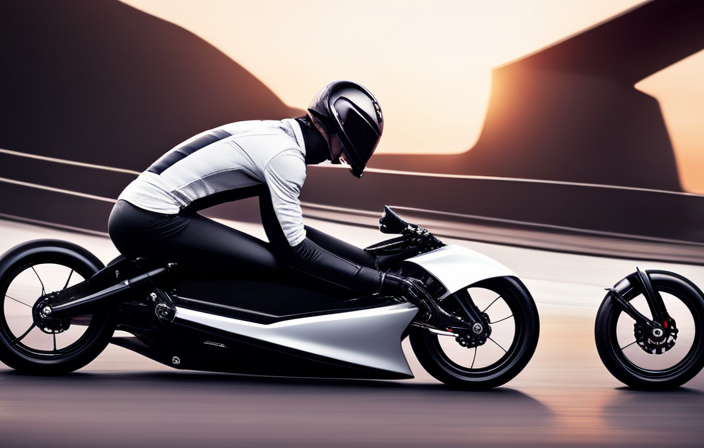As an avid electric bike enthusiast, I’m always on the lookout for ways to maximize my riding experience.
One crucial aspect that often gets overlooked is the charging time of the bike’s battery. It’s like fueling up a spaceship before embarking on an intergalactic adventure!
In this article, we will delve into the factors that affect how long it takes to charge an electric bike battery, explore average charging times, and uncover fast charging options.
So buckle up and get ready to power up your electric bike to new heights!
Key Takeaways
- Charging time for electric bike batteries is influenced by factors such as battery capacity, charger’s output power, and battery condition.
- Lithium-ion batteries charge quickly, while nickel-metal hydride batteries have good energy density and lead-acid batteries are reliable but require maintenance.
- Using the correct charger, avoiding overcharging, and charging in a cool environment can optimize charging efficiency and preserve battery lifespan.
- Fast charging options like wireless charging and high-power charging stations provide rapid charging, saving time and eliminating cable hassle.
Factors Affecting Charging Time
The charging time of your electric bike battery can be affected by several factors. One of the main factors is the charging time variability, which refers to the range of time it takes for your battery to fully charge. This variability can be influenced by the capacity of your battery.
A higher capacity battery will generally take longer to charge compared to a lower capacity one. This is because a larger capacity battery requires more energy and time to reach its full charge. Additionally, other factors such as the charger’s output power and the condition of the battery can also impact the charging time.
Understanding these factors will help you determine the approximate time it will take to charge your electric bike battery.
Now let’s move on to the next section, where we will discuss the average charging times for electric bike batteries.
Average Charging Times for Electric Bike Batteries
When it comes to electric bike batteries, there are three common types: lithium-ion batteries, nickel-metal hydride batteries, and lead-acid batteries. Each type has its own unique characteristics and charging requirements.
Lithium-ion batteries are known for their high energy density and long cycle life, making them the preferred choice for many electric bike manufacturers.
Nickel-metal hydride batteries, on the other hand, offer a good balance between energy density and cost-effectiveness.
Lead-acid batteries, although less common in electric bikes, are still used in some models due to their low cost and durability.
In this discussion, I will explore the charging times and considerations for each of these battery types.
Lithium-Ion Batteries
Lithium-ion batteries can be charged more quickly than other types of batteries due to their unique composition and design. With the advancement of technology, they have become the preferred choice for many electronic devices, including electric bikes. The charging speed of lithium-ion batteries is significantly faster compared to other battery types, allowing users to quickly replenish their electric bike’s power source.
However, it is important to note that battery maintenance plays a crucial role in ensuring optimal charging performance. Regularly monitoring and caring for the battery, such as avoiding extreme temperatures and not overcharging, can help prolong its lifespan and maintain its charging efficiency.
Now, let’s move on to discussing another type of battery commonly used in electric bikes, nickel-metal hydride batteries.
Nickel-Metal Hydride Batteries
Nickel-metal hydride batteries are commonly used in portable electronic devices due to their efficiency and relatively low environmental impact. These rechargeable batteries have been a popular choice for years, providing a reliable power source for devices such as laptops, cameras, and even electric vehicles.
When it comes to efficiency, nickel-metal hydride batteries have a good energy density, meaning they can store a significant amount of energy for their size. This allows them to power devices for longer periods before needing to be recharged. However, it’s worth noting that their energy density is lower compared to lithium-ion batteries, which have become more prevalent in recent years.
In terms of environmental impact, nickel-metal hydride batteries are generally considered to be more eco-friendly than other types, such as lead-acid batteries. They don’t contain toxic heavy metals like lead, which can be harmful to both human health and the environment. However, nickel is still a component of these batteries, and its extraction and processing can have negative environmental consequences.
Transitioning to the subsequent section about lead-acid batteries, another commonly used type of battery…
Lead-Acid Batteries
Lead-acid batteries, commonly used in vehicles and backup power systems, have been around for over a century and continue to be a reliable choice for certain applications. These batteries have a long history of use due to their ability to deliver high currents and withstand heavy loads. With proper maintenance, lead-acid batteries can last several years.
Regular maintenance includes checking electrolyte levels, ensuring proper charging voltages, and keeping the battery clean. Fast charging techniques can be employed to reduce charging times, but it’s important to note that fast charging can decrease the overall lifespan of the battery. It’s recommended to follow manufacturer guidelines for fast charging to avoid damaging the battery.
Transitioning into the next section, let’s explore the various fast charging options available for lead-acid batteries.
Fast Charging Options
You can significantly reduce the charging time of your electric bike battery by exploring fast charging options. Fast charging techniques have evolved to meet the demands of electric vehicle owners who are looking for quick and convenient ways to charge their batteries.
One option is wireless charging, which eliminates the need for cords and plugs. With wireless charging, you simply place your electric bike on a charging pad and the battery is charged through electromagnetic induction. This not only saves time but also eliminates the hassle of dealing with cables.
In addition to wireless charging, there are other fast charging techniques available, such as high-power charging stations that can provide a rapid charge. By utilizing these fast charging options, you can spend less time waiting for your battery to charge and more time enjoying your electric bike.
Now, let’s move on to some charging tips and best practices.
Charging Tips and Best Practices
To optimize the charging process for your electric bike, it’s important to follow these charging tips and best practices:
-
Use the correct charger: Using the charger specifically designed for your electric bike ensures maximum charging efficiency and prevents damage to the battery.
-
Avoid overcharging: Once your battery is fully charged, unplug it to avoid overcharging. Overcharging can reduce the lifespan of the battery and affect its overall performance.
-
Charge in a cool environment: Heat can negatively impact battery performance and longevity. It’s best to charge your electric bike in a cool, well-ventilated area to maintain optimal battery temperature.
By following these charging tips and best practices, you can ensure the charging efficiency and longevity of your electric bike’s battery.
Now, let’s explore ways to extend the battery life even further.
Extending Battery Life
By properly maintaining and caring for your electric bike’s power source, you can significantly extend its overall lifespan. To optimize charging time and ensure the longevity of your battery, there are a few key maintenance tips to keep in mind.
First, avoid overcharging your battery as it can lead to decreased performance and diminished capacity over time. Additionally, it’s important to store your battery in a cool, dry place to prevent damage from extreme temperatures. Regularly inspect and clean the battery terminals to ensure good electrical contact and prevent corrosion.
Finally, if you’re not using your electric bike for an extended period, make sure to charge the battery to around 50% before storing it. By following these battery maintenance tips, you can maximize the lifespan of your electric bike’s power source and optimize charging time.
Transitioning to the next section, let’s explore the convenience of charging time calculators and apps.
Charging Time Calculators and Apps
Using charging time calculators and apps can help you determine the optimal charging duration for your electric bike. These tools take into account factors such as battery capacity, current charge level, and charging rate to provide an accurate estimation of the time required to fully charge your battery.
By knowing the charging time estimation, you can plan your charging schedule accordingly and ensure that your electric bike is always ready to ride.
Additionally, these calculators and apps can also help in battery charging optimization. They can provide recommendations on the best charging practices to maximize the lifespan of your battery, such as avoiding overcharging or charging the battery to its full capacity.
With the help of these tools, you can efficiently manage your electric bike’s charging needs.
Speaking of charging stations and infrastructure…
Charging Stations and Infrastructure
Charging stations and infrastructure are crucial for the widespread adoption of electric vehicles. Without a robust charging infrastructure, range anxiety becomes a significant barrier for potential electric vehicle owners. Fortunately, governments around the world are taking initiatives to address this issue and promote the growth of charging infrastructure.
To give you an idea of the current state of charging infrastructure, here is a comparison table showcasing the number of charging stations available in three different countries:
| Country | Number of Charging Stations |
|---|---|
| United States | 48,817 |
| China | 808,000 |
| Germany | 28,000 |
As you can see, China leads the way with an impressive number of charging stations, followed by the United States and Germany. These numbers demonstrate the commitment of these countries towards creating an environment that supports electric vehicle adoption.
Now, let’s delve into the next section, where we will explore alternative charging methods that can further enhance the charging experience for electric vehicle owners.
Alternative Charging Methods
Have you considered exploring alternative methods to conveniently power your electric vehicle? When it comes to charging your electric vehicle, there are more options available than just traditional charging stations. Here are five alternative methods to consider:
-
Wireless Charging: This innovative technology allows you to charge your electric vehicle without the need for any cables or plugs. Simply park your vehicle over a wireless charging pad, and it will automatically start charging.
-
Solar Charging: Harness the power of the sun to charge your electric vehicle. Solar panels can be installed on your home or at charging stations to generate clean energy and charge your vehicle during the day.
-
Portable Chargers: These compact chargers can be carried with you and plugged into any standard electric outlet, providing a convenient way to charge your electric vehicle on the go.
-
Public Charging Stations: Many cities and towns have installed public charging stations, allowing you to charge your vehicle while running errands or enjoying a day out.
-
Workplace Charging: Some companies offer charging stations at their workplaces, enabling you to charge your electric vehicle while you’re at work.
By exploring these alternative methods, you can find convenient and eco-friendly ways to keep your electric vehicle charged and ready to go.
As we move on to discussing battery swapping services, let’s dive into another aspect of charging your electric vehicle.
Battery Swapping Services
On-demand battery exchanges are a convenient and efficient solution for electric vehicle owners who want to quickly recharge their batteries. These services allow users to swap their depleted battery with a fully charged one, eliminating the need to wait for a lengthy charging process.
The benefits of on-demand battery exchanges include reduced downtime, increased range, and the ability to continue using the vehicle without interruption.
However, limitations such as the availability and accessibility of these services can vary depending on location and infrastructure development.
On-Demand Battery Exchanges
If you’re in a hurry, you can easily swap out your electric bike battery for a fully charged one. Battery swapping technology has revolutionized the way we think about charging electric bikes.
It offers a convenient and efficient solution for those who don’t have the time to wait for their battery to charge. With battery swapping, you can simply exchange your depleted battery for a fully charged one at specialized stations.
This technology not only saves you time but also has a positive impact on battery lifespan. By using different batteries in rotation, you can avoid overcharging and extend the overall lifespan of your batteries. This ensures that your electric bike remains reliable and functional for a longer period of time.
Moving on to the benefits and limitations of battery swapping…
Benefits and Limitations
Battery swapping technology revolutionizes the way we charge our electric bikes, offering convenience and efficiency for those with time constraints. With this technology, the charging speed of electric bike batteries is significantly improved. Instead of waiting for hours for a full charge, users can simply swap out their depleted battery for a fully charged one in a matter of seconds.
This allows riders to get back on the road quickly, without the need to plan their trips around charging stations. Additionally, battery swapping reduces the environmental impact of electric bikes. By eliminating the need for individual charging, it reduces the strain on the power grid and decreases the overall carbon footprint.
However, it is important to note that the availability and accessibility of battery swapping stations are still limited, hindering widespread adoption.
Availability and Accessibility
When it comes to swapping out your depleted battery for a fully charged one, you may find that the availability and accessibility of swapping stations are still limited. However, there are solutions being developed to address these challenges.
Here are a few things to consider:
-
Swapping stations: These stations are strategically placed to ensure easy access for electric bike users.
-
App integration: Some companies are working on apps that allow users to locate the nearest swapping station.
-
Extended operating hours: Stations that operate 24/7 ensure that riders can swap their batteries at any time.
-
Increased station density: As demand grows, more swapping stations will be added to improve accessibility.
-
Standardization: Developing industry-wide standards will make swapping stations compatible with different brands and models.
As we look towards the future, advancements in battery charging technology will likely address the availability and accessibility challenges even further.
Future Developments in Battery Charging Technology
As technology advances, we can expect faster and more efficient charging of electric bike batteries in the future. One exciting development is the possibility of wireless charging. This means that instead of having to physically connect your bike to a charger, you could simply park it in a designated area and it would automatically start charging. This would greatly improve convenience and eliminate the need for messy cables.
Another promising advancement is solar charging. Imagine being able to harness the power of the sun to charge your electric bike battery. Solar panels could be integrated into the bike’s design, allowing you to charge your battery while on the go. This would not only make charging more environmentally friendly, but it would also increase the range of your electric bike.
Overall, these developments in battery charging technology hold great promise for the future of electric bikes.
Frequently Asked Questions
Are there any specific charging methods that can significantly extend the lifespan of an electric bike battery?
There are alternative charging methods that can significantly extend the lifespan of an electric bike battery. These methods include slow charging, avoiding overcharging and deep discharging, and keeping the battery at optimal temperature.
How can I find charging stations and infrastructure specifically designed for electric bikes?
Finding charging stations and battery swapping services for electric bikes can be easily done by using online maps or apps specifically designed for this purpose. These tools provide detailed information and location services for convenient charging options.
Are there any alternative charging methods available for electric bike batteries other than charging them directly from a power outlet?
Wireless charging and solar charging are alternative methods available for electric bike batteries. Wireless charging uses electromagnetic fields to transfer energy, while solar charging harnesses the power of the sun to charge the battery. Both options provide convenient and eco-friendly charging solutions.
Are there any battery swapping services available for electric bike batteries, similar to those offered for electric cars?
Battery swapping services for electric bike batteries offer several benefits such as quick and convenient battery exchange, eliminating the need for charging infrastructure. However, challenges like standardization and compatibility need to be addressed to make it feasible compared to traditional charging methods.
What are some future developments in battery charging technology that could potentially affect the charging time of electric bike batteries?
Wireless charging and fast charging are two exciting developments in battery charging technology that could significantly reduce the charging time of electric bike batteries. These advancements could revolutionize the way we charge our electric bikes, making it faster and more convenient.
Conclusion
In conclusion, the charging time of an electric bike battery depends on various factors such as battery capacity, charger type, and charging method. On average, it takes around 3-6 hours to fully charge an electric bike battery. However, with fast charging options and advancements in battery technology, this time can be significantly reduced.
It is important to follow charging tips and best practices to ensure optimal battery performance and longevity. As battery charging infrastructure continues to expand, alternative methods like battery swapping services may also become more prevalent.
The future holds exciting developments in battery charging technology, promising even faster and more efficient charging times. Just like a well-oiled machine, electric bike batteries will keep powering our rides for years to come.
















